When you visit Key West, sometimes known as the Conch Republic, you may hear some phrases you don’t understand or read some place names you can’t pronounce.
Here to help is Karuna Eberl and Steve Alberts, who recently lived on Cudjoe Key in the Lower Keys, and bring a local’s perspective to their entertaining book “Key West & the Lower Keys Travel Guide.” This is an excerpt from their book.
A Conch Republic dictionary
Backcountry: the shallow waters of the gulfside, with mangrove islands, channels and tidal flats, popular for fishing and kayaking. Also called the flats.
Bahia Honda: a state park near mile marker 37, known for its scenic beaches and difficult pronunciation. Conchs say Bay-ah or Bee-ya, which is also how the recording on the interpretive exhibit says it. Most others use the typical Spanish sounding of Bah-hee-ah.
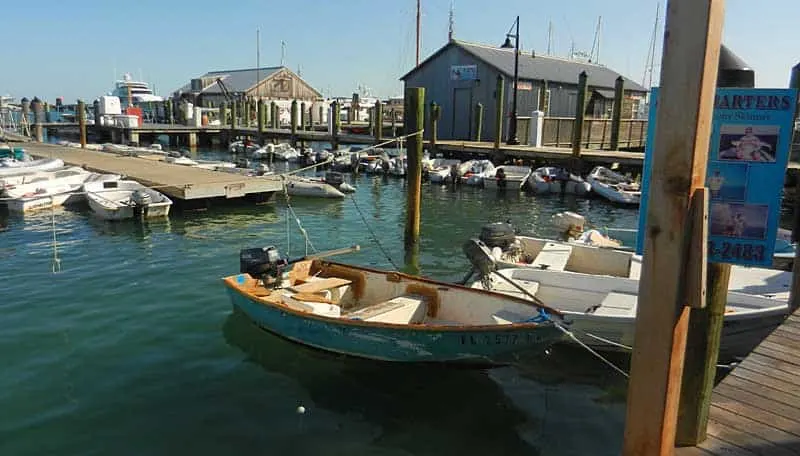
Bight: a bend or recess in a shoreline that makes a bay and/or harbor. The historic seaport in Key West is also called the Key West Bight.
Bone Island: Key West. See also Cayo Hueso.
Bubba, Bubba System: in the friendly definition, Bubbas are long-time members of the community who look out for one another. In another definition, the Bubba system is a deeply rooted network of developers, landowners and politicians who bend rules to ensure their mutual continued financial success — or, more simply, politics.
Bucci: Cuban coffee served in a small cup like espresso, very strong, usually with sugar. Also called Cuban crack.
Bug: Spiny lobster, rock lobster, Caribbean lobster, Florida lobster. Some call fishing for lobster bug hunting. Also what the DEA plants in people’s houses for surveillance. Also an insect, with six legs.
Buoys: Floating balls used to designate something underwater or an area above it. Cantaloupe-size styrofoam balls designate the location of lobster and crab traps in the water before they are retired into art and patio decorations. Buoy season on the water runs from August when lobster season opens, through mid-May, when stone crab season closes.
Café Con Leche: Cuban coffee like a latte, using a strong bucci shot(s), steamed milk, and often sugar. When you order, they will ask you how many sugars you want. One is light, three are quite sweet.
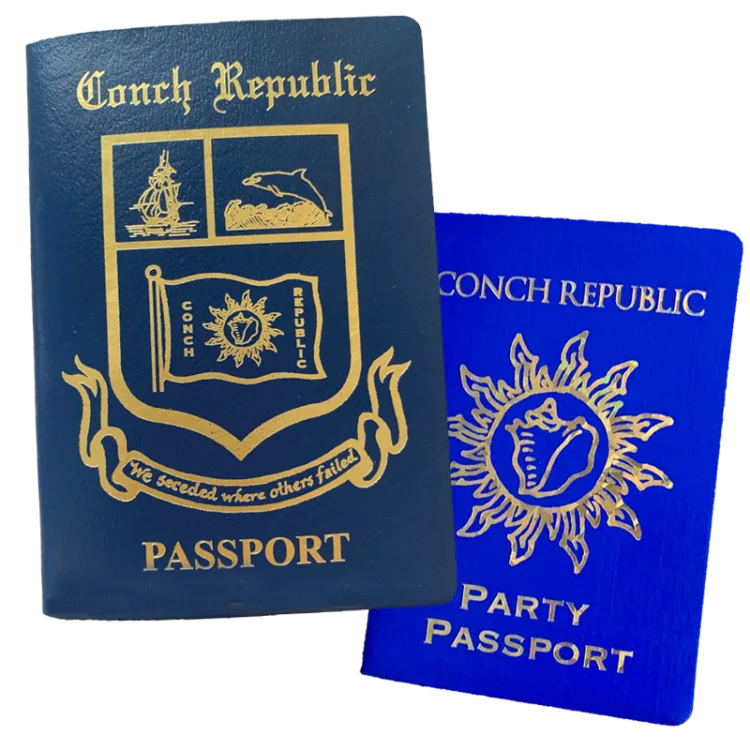
Cast Net: a mesh net with weights around the edge, which is thrown into the water to catch bait fish.
Cayo Hueso: Key West. The original name given to the island by the Spanish, translates to Bone Key. The name was given either because of the seven-year apple trees found here, which the Spanish called hueso elsewhere, or because of human remains (bones) found here. Eventually it became Key West, either because of its geographical location on the west end of the island chain, or because of a mistaken translation of hueso for ouest (Spanish for west).
Chickee: Seminole word for house, another name for a tiki hut.
Cold Air: to locals, anything below 73 degrees (23C).
Cold Water: to locals, anything below 80 degrees (26C).
Conch: a person born in Key West. Also a shelled sea animal and popular food.
Conch Cruiser: a hand-painted car, truck or bicycle, often decorated with shells, flowers, shark effigies, and other artistic creations. Usually they never leave the Keys, like the people who created them.
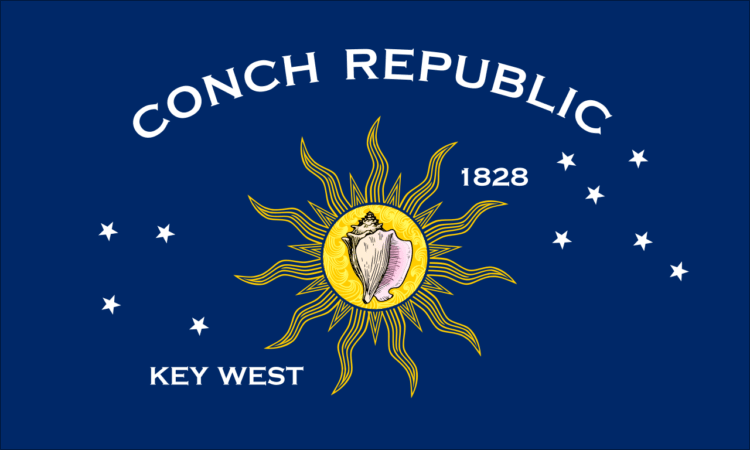
Conch Republic: an unofficial micro-nation created when Key West seceded from the United States in 1982. “A sovereign state of mind seeking to bring more humor, warmth and respect to a world in sore need of all three.”
The Conch Republic celebrates its 40th anniversary in 2022. It’s motto: “People who seceded where others have failed.” Here’s the official site for the Conch Republic.
Cortadito: a bucci with a little milk, a small cafe con leche.
Cuba Libre: rum and Coke, traditionally with lime. It translates to “free Cuba,” a toast given by U.S. Army Captain Russell in 1900 while celebrating the U.S. victory over Spain there, which happened to lead to the first importation of Coca-Cola into the country. “Por Cuba libre,” may the day be not too far off again, for freedom.
Cuban Chug: many brave souls have attempted to cross the ocean from Cuba, Haiti, and other lands afar on makeshift boats. Those found tucked in mangroves and abandoned on secluded beaches likely were the successful ones, and their journeys and resourceful vessels are quite a feat to ponder. You see see some Cuban Chugs on display at the Key West Botanical Garden.
Dinghy: a small boat, with or without a motor, used by those living on the hook (docked offshore) as transportation to and from shore.
Directions: the Keys don’t really use traditional directions. Up is north and east, toward the mainland. Down is south and west toward Key West. Gulfside is the side of the road the Gulf of Mexico is on, which is on your right or starboard going down and left or port going up. Oceanside is the Atlantic on your left going down and right going up. Bayside is the same as gulfside, which is also where the backcountry flats are.
Dolphin: Most often here it means dolphinfish, a.k.a. mahi-mahi or dorado. When it’s on a menu, that is definitely what it means. Sometimes it means dolphin mammal, like Flipper. Those are not eaten here. But they do live here.
Draw, Draft: the amount the hull of a boat and/or propeller sticks underwater. The less draw, the shallower of water the boat can travel in without grounding. Skiffs draw around a foot, while sailboats can draw four feet or more. Also good terms for after boating, as in a bartender can draw you a good draft beer once you’re back on land.
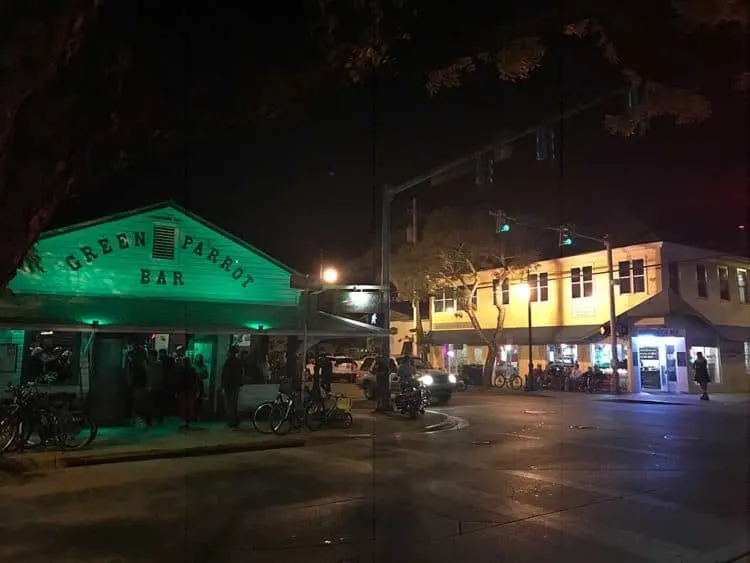
Duval Crawl: bar-hopping down Duval Street, or after too much bar-hopping, the only way to get back to the hotel.
Four Lane: The final stretch of highway leading to Key West where the speed limit increases to 55 m.p.h. and there are finally two lanes in each direction for passing. It’s also a favorite speed-trap for police.
Freshwater Conch: an honorary citizen of Key West, or someone who has lived here seven years.
Galleons: Spanish treasure fleets brought their New World wealth to Spain aboard galleons. Some fleets were ill-fated. A hurricane sank the 1622 fleet west of Key West. In the mid 1980s Mel Fisher and crew found two of those galleons: the Nuestra Señora de Atocha and the Santa Margarita. In 1733 a hurricane sank another fleet, which Art McKee would find in 1938. He soon opened a treasure museum in Islamorada, which was the first of its kind in the world.
Green Flash: an optical phenomenon at the moment of sunset, where green rays emanate from the sun dipping below the horizon. It is not a myth, though atmospheric conditions often prevent seeing it.
Grouper: Goliath grouper can grow to 800 pounds (455 kg) and over 8 feet (2 meters) and are a critically endangered fish, though some divers and snorkelers are lucky enough to spot them. Non-endangered species of grouper are a favorite local menu item.
Gulfside: the side of the Keys toward the Gulf of Mexico. See also “bayside” and “directions.”
Gypsy Chicken: a free-roaming Key West chicken, beloved by many and bemoaned by some, especially when they crow at 3 a.m. They were probably brought here in the 1800s for eggs and food, then later for cock-fighting sport. Once that became illegal, their lives have been mostly peaceful ever since. Read more about Key West chickens here.
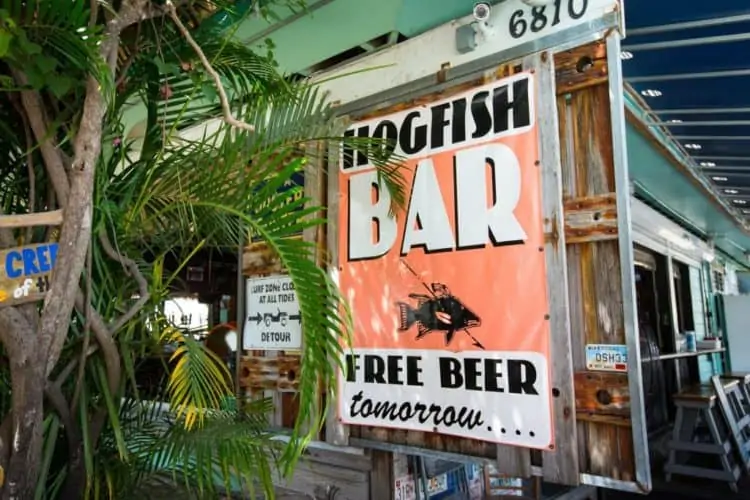
Hogfish: A reef fish that’s a must-try for eating. A restaurant on Stock Island that’s popular for serving it.
Howard Livingston: Along with his Mile Marker 24 Band, Howard plays happy island music around the Keys and beyond. If you were hoping to catch that cheeseburger-eating, margarita-drinking sailor, you’ll likely love Howard.
Iguana: fascinating, prehistoric-looking, big mostly vegetarian lizards, usually green, brown, black or orange. They’re invasive but not aggressive, just don’t handle their bacteria-laden poop.
Islamorada: The Keys roughly between Tavernier and Craig Key, translates to “Village of Islands” and/or “purple isle.” Great fishing, but hard pronunciation. Spanish speakers want to say eesla-moraah-dah. Locals say eye-lah-mor-ah-dah. More about Islamorada.
Key: A small island. Probably adapted by the Spanish from the indigenous Hispaniola words cayo and cayuelo (very small island). The English used cay or kay, and it is likely that varying pronunciations morphed into the word Key. Keys are also good for starting cars, opening locked doors, and interpreting secret codes.
Key Lime: A citrus fruit more sour and aromatic than typical Persian limes. They are the key ingredient in Key West-born Key lime pie, though most of the limes are now grown on the mainland and Central America since hurricanes wiped out the Keys lime farms a while back.
Keys Disease: In the negative sense, it is someone who is unable to resist the temptations of living in a vacation mecca, who parties too hard and ends up burnt out, homeless or otherwise dysfunctional in society. In the positive sense, it is a focus on simplifying life so as to be able to enjoy each day to its fullest, which includes shedding material possessions and finding a way to earn a living that is compatible with one’s beliefs. Either way, once you have contracted it, going back to an office job on the mainland is no longer a possibility.
LiveAboard: a motorboat, sailboat or houseboat that serves as one’s primary residence. Typically these are docked at a marina or “on the hook,” though sometimes they are dry-docked on land. It’s sometimes a free and romantic existence, but not without its inconveniences. Some liveaboards are able to motor and sail, while others are simply floating quarters.
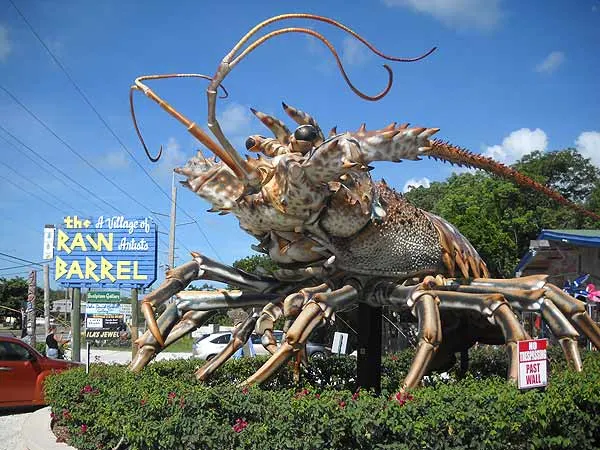
Lobster: A crustacean. The Caribbean spiny lobster is served widely in Keys restaurants. It has no claws, unlike its northern cousins. Also called bugs and crawdads. Lobster also refers to a sunburnt tourist.
Mainland: noun: geographically, anything north of Key Largo. adjective: a state of mind that is usually associated with overly aggressive drivers, people who take themselves too seriously, those who don’t respect the environment, or depressed souls who watch TV news and discuss national politics.
Mid Town: a designation for an area of Key West between New Town and Old Town. We surmise land brokers originally fabricated this shoulder neighborhood in order to inflate prices, as the only maps we can find designating “Mid Town” are courtesy of real estate offices.
MM: Short for mile marker, the unit for distance measurement on the Overseas Highway. Green road signs display each mile, starting with MM 107 in Key Largo and ending at MM 0 in Key West. Addresses along the Overseas Highway mostly correspond with mile markers. For example, 82990 Overseas Highway is at MM 82.99, or basically right by the MM 83 sign. This address system falls apart in Marathon and then again in the Saddlebunch Keys, but is otherwise reliable. Florida Rambler offers a guide to driving the Overseas Highway mile marker by mile marker.
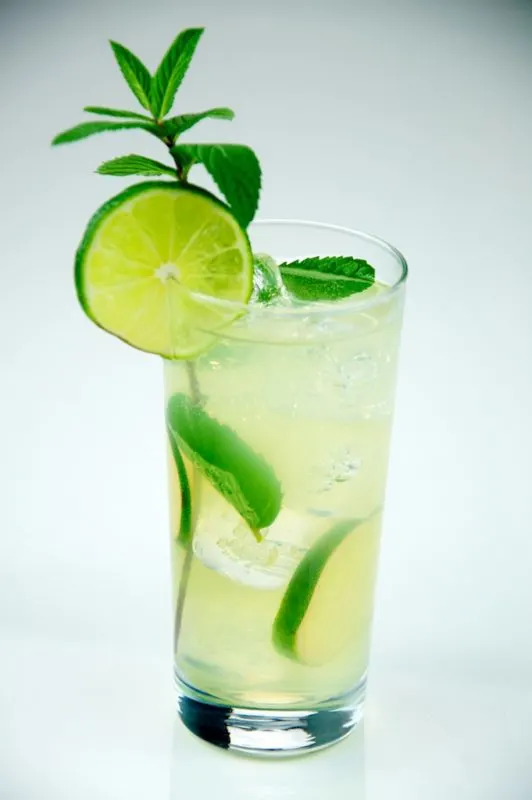
Mojito: Alcoholic drink containing ample Key lime juice, muddled mint, sugar, white rum, soda water, and ice. Only order one from a reputable bar when the bartender is slow, as they take patience to make correctly and require fresh ingredients, not mixes. Cuban origin.
Mooring Balls: a floating ball attached to a permanent structure on the seabed, which boats can tie off to in harbors and around reefs.
Mullet: a fish that is good smoked and often used for bait. Essential for the ecosystem, they are food for most sportfish and keep the water clean by feeding on algae and other bottom decay. As they eat off of the bottom, they sometimes create temporary milky clouds in the water. Also a hairstyle that is short in the front and long in the back, or as Joe Dirt described “business in the front and party in the back.” Rocked by Rod Stewart and Chuck Norris, among others.
New Town: The section of Key West that roughly corresponds to the area east and north of 1st Street and Palm Ave., which includes all of the big box stores.
No Take Zone: an area of particular environmental sensitivity, often around popular diving sites, where no fishing or lobstering may be done. The zones are denoted by a perimeter of 30-inch yellow buoys, as well as on most nautical charts.
Oceanside: Anything south or east of the Overseas Highway.
Old Town: The section of Key West that roughly corresponds to the area south and west of 1st Street and Palm Ave., which includes the historic districts, seaport, and Duval Street.
On the Hook: A boat that is anchored or moored offshore. Many people live on the hook in the Keys. It’s a simple existence, welcomed by souls strong or stubborn enough to brave dinghy rides to shore and a lack of air conditioning, refrigeration, and on-board showers. The trade-off is lower rent or none at all. On the hook can also refer to a fish that has taken the bait, or a lady or dude at the bar who appears to be willing to go home to consummate the first date with you.
Overseas Highway: The roadway between mainland Florida and Key West. The last 126 miles of the 2,369-mile highway U.S. Route 1.
Parrotheads: Jimmy Buffett fans, though we’re not sure if the king of island music actually approves of their practices, which can include simultaneously wearing several patterns of Hawaiian shirt, fake flower leis, plastic parrot beaks and sombreros with squeaky cheeseburgers, flamingos and sharks hanging from them. Then again, in the words of Jimmy, “if we couldn’t laugh we would all go insane.”
Pinks: Key West pink shrimp are wild-caught in the Keys. They are characterized by a mild, sweet flavor and their pink color when raw. Only 3 percent of the total Gulf of Mexico harvest are pinks, though in the Keys we enjoy the fortune of having them on most menus.
Rock (The): What some people call Key West, especially in reference to those who never make it “off the Rock,” to the mainland or even as far as over the 300-foot bridge to Stock Island.
Rum: the unofficial drink of the Caribbean and the Conch Republic, made from fermented and distilled sugarcane. It comes in dark and light, depending on the type of aging, and is the backdrop for many a sea tale of pirates, rum-runners, adventurers, and other ne’er-do-wells.
Rum-Runner: a concoction of rum and any number of juices and liqueurs, including pineapple, orange, blackberry, banana, and grenadine. It was probably invented at the Holiday Isle (now Postcard Inn) Tiki Bar at MM 84 in the 1950s. Rum-runners smuggled rum from Bimini to Florida during prohibition in the 1920s and ‘30s. They were a surly, adventurous, dangerous, and beloved group, depending on which history you prefer.
Sargassum: Sounds like a made-up word, but is actually floating brown seaweed that harbors life for many small creatures. Large patches of it are good places to fish for dolphinfish.
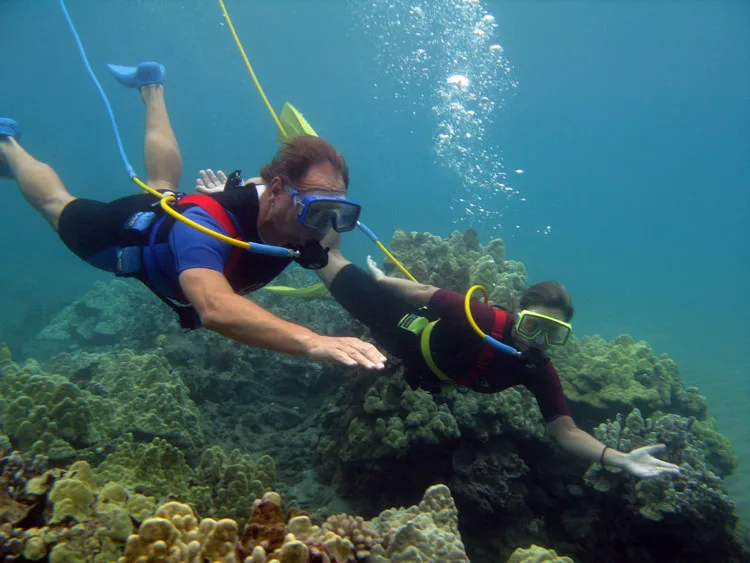
Scuba, Snuba, Snorkel: Scuba divers strap an air tank on their back and dive underwater. They must be PADI or NAUI certified. Snuba divers jump in the water with a hose that delivers fresh air from above, and requires no certification. Snorkelers float on the surface of the water and breathe through a tube, also no certification.
Skiff: a small boat with a partially flat bottom, popular in the Keys for its shallow draft, which makes the backcountry more accessible.
Snapper: A popular sport and culinary fish, coming in species including yellowtail, mangrove, mutton, and red. Also what the Jets and the Sharks do in the heat of a West Side Story music-dance-off.
Snook: Another popular sport and culinary fish.
Square Grouper: an abandoned bale of weed, cocaine or cash found floating in the ocean or tangled in the mangroves, which allows the finder to unexpectedly retire. Also a good restaurant at MM 22.5.
Stock Island: the island directly north of Key West, home to a few good restaurants, marinas, and the commercial fishing and lobster yards. It has a reputation for being a little rough-and-tumble, but is generally safe during daylight hours.
Stretch (The): The 18 miles between the mainland and Key Largo, which is contained within claustrophobic cement barriers painted happy blue to mitigate road-rage from those who want to speed but cannot because much of it is a single lane in each direction. It is often perceived as a bit of a long, dull chore on the drive north, yet as an exciting threshold to cross on the way south.
SUP: Acronym for standup paddleboarding, or stand-up paddle boarding, or stand up paddle-boarding. Besides being a sport that has been particularly skilled in evading a standard spelling, it’s a fast-growing form of healthy recreation that draws an abundance of fit bodies in bikinis and board shorts. Imagine surfing, but without waves, using a big paddle to push yourself along. Also a greeting, from the shortening of the phrase, “What’s up.”
Tickle Stick: a pole used to coax lobster from their rocky hideouts.
Tiki Hut: a thatched-roof structure, usually with open walls, containing a bar, restaurant, or hangout spot. While they give a nod to Polynesian culture, their origins in south Florida come from the Native American tribes who developed the building technique in the 1800s while being chased into the Everglades by American troops. Today those tribes build most of the tikis in the Keys. Visit a tiki hut at these favorite Keys tiki bars.
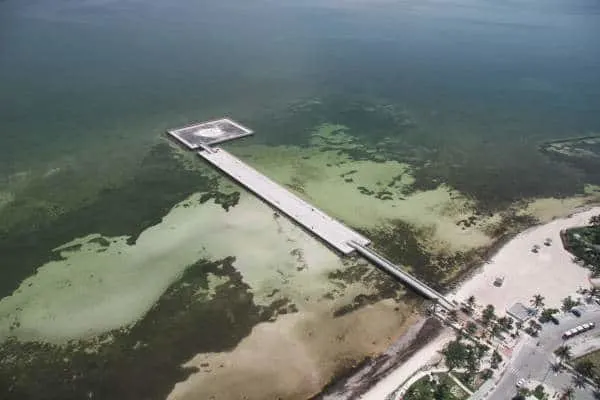
Unfinished Highway to Havana: the pier on the end of White Street in Key West, which kind of appears to be the beginning of a bridge to Cuba. In 2016 the pier was renamed after philanthropist and developer Edward B. Knight, but most people missed or ignored the memo and still call it the White Street Pier.
Winter: what we see at Christmas when we visit family up north.
Other articles written for FloridaRambler.com by Karuna Eberl and Steve Alberts. Karuna Eberl also writes about ideas and nature in her blog Nature Rising.
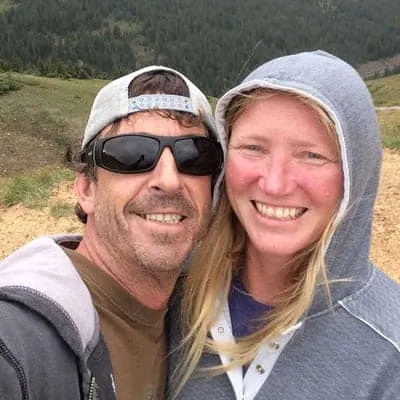
Karuna Eberl and Steve Alberts live on Cudjoe Key in the Lower Keys, where they write and photograph for local and national publications, most often with a focus on travel, adventure and the environment. You can visit their web sites at quixotictravelguides.com and wanderingdogcreations.com

Megan
Monday 10th of January 2022
I can't believe y'all didn't mention "boongie". As a 6th generation Conch, I'm extremely disappointed.
Btw, I think you meant "sea TALE" under the definition for rum. Sorry to be a grammar nazi.
Megan
Saturday 15th of January 2022
@Bonnie Gross, Yes ma'am!
A lot of we conchs have Bahamian ancestry.
I'm surprised you've never heard someone say it!
Bonnie Gross
Monday 10th of January 2022
Thanks for the correction on sea tale! We appreciate it.
As for boongie, I had to look that one up. An internet slang site says: "Boongie - 1. Bahamian for "butt" or "ass" sometimes including the upper thighs. Bahamians have a preference for well developed boongies."
Joy Sargent-Smith
Saturday 4th of September 2021
That is not the definition of fresh water conch I have heard. I was born in Key West but my parents were not, so I was called a fresh water conch. Never heard of the honorary conch or 7 yr rule in relation to the term.